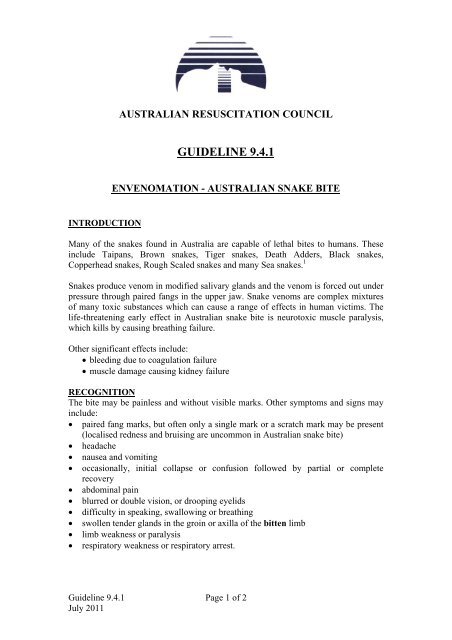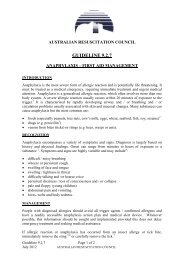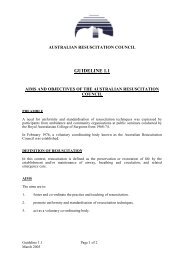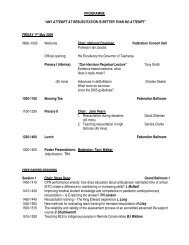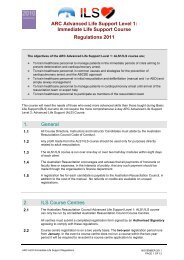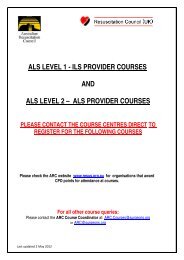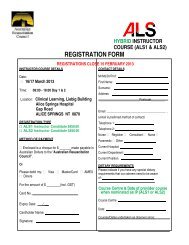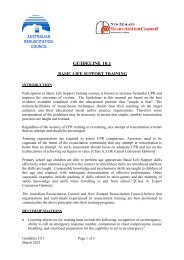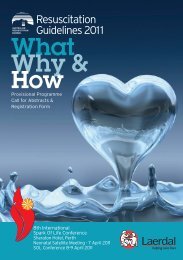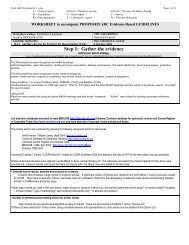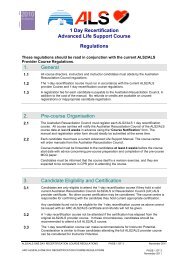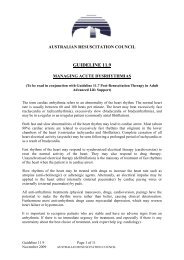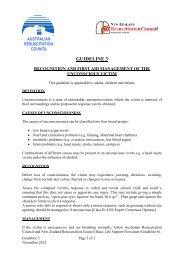Guideline 9.4.1 - Australian Resuscitation Council
Guideline 9.4.1 - Australian Resuscitation Council
Guideline 9.4.1 - Australian Resuscitation Council
You also want an ePaper? Increase the reach of your titles
YUMPU automatically turns print PDFs into web optimized ePapers that Google loves.
AUSTRALIAN RESUSCITATION COUNCIL<br />
GUIDELINE <strong>9.4.1</strong><br />
ENVENOMATION - AUSTRALIAN SNAKE BITE<br />
INTRODUCTION<br />
Many of the snakes found in Australia are capable of lethal bites to humans. These<br />
include Taipans, Brown snakes, Tiger snakes, Death Adders, Black snakes,<br />
Copperhead snakes, Rough Scaled snakes and many Sea snakes. 1<br />
Snakes produce venom in modified salivary glands and the venom is forced out under<br />
pressure through paired fangs in the upper jaw. Snake venoms are complex mixtures<br />
of many toxic substances which can cause a range of effects in human victims. The<br />
life-threatening early effect in <strong>Australian</strong> snake bite is neurotoxic muscle paralysis,<br />
which kills by causing breathing failure.<br />
Other significant effects include:<br />
bleeding due to coagulation failure<br />
muscle damage causing kidney failure<br />
RECOGNITION<br />
The bite may be painless and without visible marks. Other symptoms and signs may<br />
include:<br />
paired fang marks, but often only a single mark or a scratch mark may be present<br />
(localised redness and bruising are uncommon in <strong>Australian</strong> snake bite)<br />
headache<br />
nausea and vomiting<br />
occasionally, initial collapse or confusion followed by partial or complete<br />
recovery<br />
abdominal pain<br />
blurred or double vision, or drooping eyelids<br />
difficulty in speaking, swallowing or breathing<br />
swollen tender glands in the groin or axilla of the bitten limb<br />
limb weakness or paralysis<br />
respiratory weakness or respiratory arrest.<br />
<strong>Guideline</strong> <strong>9.4.1</strong> Page 1 of 2<br />
July 2011
Note:<br />
Life-threatening effects may not be seen for hours. However when massive<br />
envenomation occurs, especially in children, symptoms and signs may appear within<br />
minutes.<br />
MANAGEMENT<br />
The rescuer should:<br />
keep the victim at rest, reassured and under constant observation<br />
commence resuscitation if necessary, following the <strong>Australian</strong> <strong>Resuscitation</strong><br />
<strong>Council</strong> and New Zealand <strong>Resuscitation</strong> <strong>Council</strong> Basic Life Support Flowchart<br />
(<strong>Guideline</strong> 8)<br />
apply the Pressure Immobilisation Technique (<strong>Guideline</strong> 9.4.8)<br />
transport the victim to a medical facility, preferably by ambulance<br />
Note:<br />
DO NOT cut or incise the bite<br />
DO NOT use an arterial tourniquet<br />
DO NOT wash or suck the bite<br />
Snake identification<br />
Identification of venomous snakes can be made from venom present on clothing or<br />
the skin using a Venom Detection Kit. For this reason do not wash or suck the bite or<br />
discard clothing. It is not recommended to kill the snake for purposes of<br />
identification, because medical services do not rely on visual identification of the<br />
snake species.<br />
Antivenom is available for all venomous <strong>Australian</strong> snake bites.<br />
REFERENCES<br />
1. Sutherland SK, Tibballs J. <strong>Australian</strong> Animal Toxins. Melbourne: Oxford<br />
University Press 2001.<br />
FURTHER READING<br />
ARC <strong>Guideline</strong> 8 Cardiopulmonary <strong>Resuscitation</strong><br />
ARC <strong>Guideline</strong> 9.4.8 Envenomation - Pressure Immobilisation Technique<br />
RATIONALE FOR PRESSURE IMMOBILISATION<br />
Most snake venom reaches the blood stream via the lymphatic system. Research has<br />
shown that very little venom reaches the circulation, even after several hours, if the<br />
Pressure Immobilisation Technique is applied immediately and maintained.<br />
<strong>Guideline</strong> <strong>9.4.1</strong> Page 2 of 2<br />
July 2011


